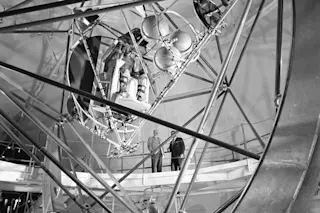Thousands of people have applied to with NASA to be astronauts since 1959, but less than 400 have been chosen. The lucky few must complete about four years of training before getting launched into space. This training includes miles of sustained running in 120-pound space suits while holding weights, enduring extreme temperatures, and being plunged into frigid water, dropped from airplanes, and flung about in motion simulators. All this punishment makes for great pictures, allowing the rest of us to simply watch and perhaps feel a little better about being earthbound.
All images courtesy NASA
1957: The Gimbal Rig was engineered to simulate the tumbling and rolling motions of a space capsule and train the Mercury astronauts to control roll, pitch and yaw by activating nitrogen jets, used as brakes and bring the vehicle back into control. This facility was built at the Lewis Research Center, now John H. Glenn ...














